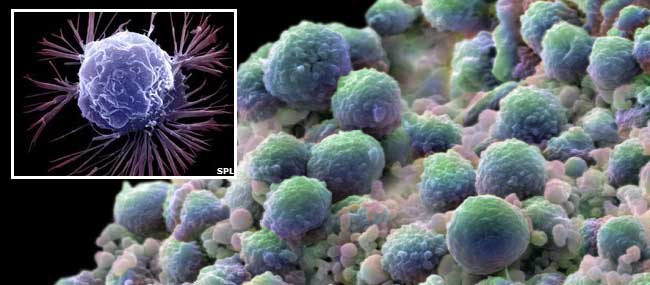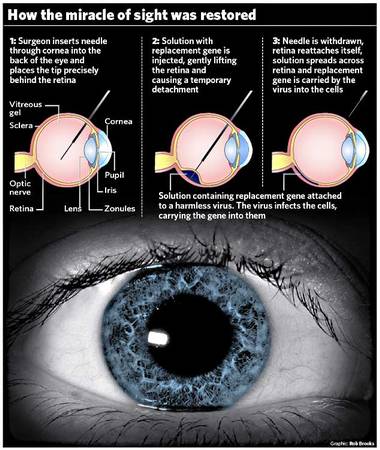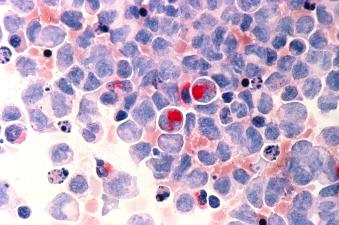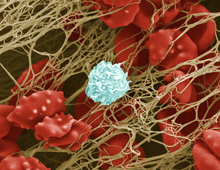FOLLOWING are some of the recent developments in Gene Therapy:
· Nanotechnology + gene therapy yields treatment to torpedo cancer. March, 2009. The School of Pharmacy in London is testing a treatment in mice, which delivers genes wrapped in nanoparticles to cancer cells to target and destroy hard-to-reach cancer cells.[28] |  |
· Results of world's first gene therapy for inherited blindness show sight improvement. 28 April 2008. UK researchers from the UCL Institute of Ophthalmology and Moorfields Eye Hospital NIHR Biomedical Research Centre have announced results from the world’s first clinical trial to test a revolutionary gene therapy treatment for a type of inherited blindness. The results, published in the New England Journal of Medicine, show that the experimental treatment is safe and can improve sight. The findings are a landmark for gene therapy technology and could have a significant impact on future treatments for eye disease.[29] |  |
Previous information on this trial (May 1, 2007): A team of British doctors from Moorfields Eye Hospital and University College in London conduct first human gene therapy trials to treat Leber's congenital amaurosis, a type of inherited childhood blindness caused by a single abnormal gene. The procedure has already been successful at restoring vision for dogs. This is the first trial to use gene therapy in an operation to treat blindness in humans.[30]
· A combination of two tumor suppressing genes delivered in lipid-based nanoparticles drastically reduces the number and size of human lung cancer tumors in mice during trials conducted by researchers from The University of Texas M. D. Anderson Cancer Center and the University of Texas Southwestern Medical Center. (January 11, 2007).
· Researchers at the National Cancer Institute (NCI), part of the National Institutes of Health, successfully reengineer immune cells, called lymphocytes, to target and attack cancer cells in patients with advanced metastatic melanoma. This is the first time that gene therapy is used to successfully treat cancer in humans. (August 30, 2006). [31] |  |
· Gene therapy is effectively used to treat two adult patients for a disease affecting non-lymphocytic white blood cells called myeloid cells. Myeloid disorders are common and include a variety of bone marrow failure syndromes, such as acute myeloid leukemia. The study is the first to show that gene therapy can cure diseases of the myeloid system. (March 31, 2006). [32]
|  |
· Gene Therapy cures deafness in guinea pigs. Each animal had been deafened by destruction of the hair cells in the cochlea that translate sound vibrations into nerve signals. A gene, called Atoh1, which stimulates the hair cells' growth, was delivered to the cochlea by an adenovirus. The genes triggered re-growth of the hair cells and many of the animals regained up to 80% of their original hearing thresholds. This study, which many pave the way to human trials of the gene, is the first to show that gene therapy can repair deafness in animals.[33]
|
 |
· University of California, Los Angeles, research team gets genes into the brain using liposomes coated in a polymer call polyethylene glycol (PEG). The transfer of genes into the brain is a significant achievement because viral vectors are too big to get across the "blood-brain barrier." This method has potential for treating Parkinson's disease. (March 20, 2003).[34]
· RNA interference or gene silencing may be a new way to treat Huntington's. Short pieces of double-stranded RNA (short, interfering RNAs or siRNAs) are used by cells to degrade RNA of a particular sequence. If a siRNA is designed to match the RNA copied from a faulty gene, then the abnormal protein product of that gene will not be produced. (March 13, 2003).[35]
· New gene therapy approach repairs errors in messenger RNA derived from defective genes. Technique has potential to treat the blood disorder thalassaemia, cystic fibrosis, and some cancers. (October 11, 2002).[36] |  |